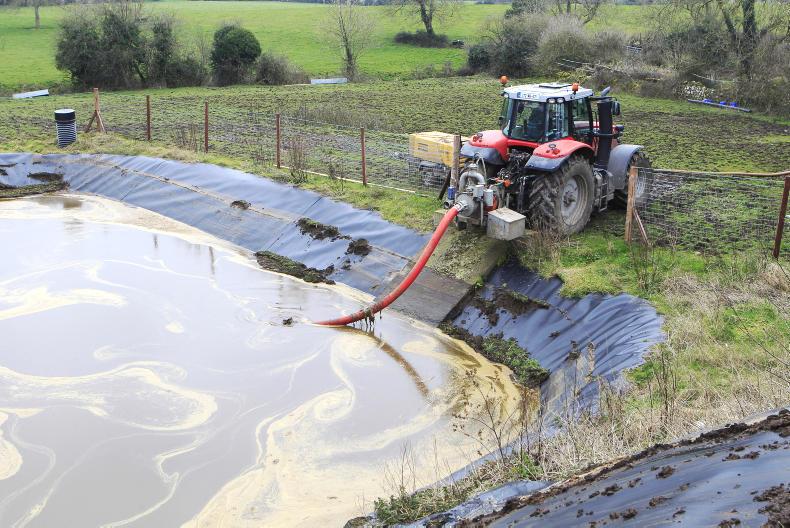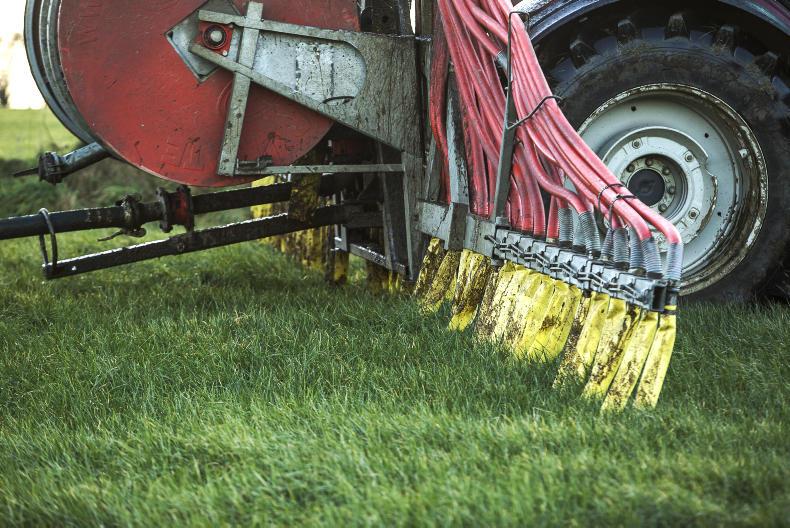Slurry is an important source of N, P and K, and its effective use is essential to balancing soil fertility levels. To maximise the nutrient value of either cattle or pig slurry over the coming weeks and months to rebuild silage stocks a number of decisions must be made. Firstly, where on the farm should slurry be applied to maximise slurry P and K? Secondly, when is the most efficient time to apply slurry to maximise N recovery?

The method of slurry application (splashplate or trailing shoe/band spreader) will have a large effect on nitrogen losses. The splashplate technique broadcasts slurry across the full spread width and, depending on timing/weather conditions, high levels of N loss may occur as a result.
Slurry is an important source of N, P and K, and its effective use is essential to balancing soil fertility levels. To maximise the nutrient value of either cattle or pig slurry over the coming weeks and months to rebuild silage stocks a number of decisions must be made. Firstly, where on the farm should slurry be applied to maximise slurry P and K? Secondly, when is the most efficient time to apply slurry to maximise N recovery?
 The method of slurry application (splashplate or trailing shoe/band spreader) will have a large effect on nitrogen losses. The splashplate technique broadcasts slurry across the full spread width and, depending on timing/weather conditions, high levels of N loss may occur as a result.
The method of slurry application (splashplate or trailing shoe/band spreader) will have a large effect on nitrogen losses. The splashplate technique broadcasts slurry across the full spread width and, depending on timing/weather conditions, high levels of N loss may occur as a result.
The method of slurry application (splashplate or trailing shoe/band spreader) will have a large effect on nitrogen losses. The splashplate technique broadcasts slurry across the full spread width and, depending on timing/weather conditions, high levels of N loss may occur as a result.
Targeted application of slurry based on soil test results will ensure efficient use of early-season P and K in satisfying grass requirements. The typical value of 1,000gal of cattle or pig slurry applied by splashplate in springtime has an available N-P-K content equivalent to a 50kg bag of 6-5-32 and 13-7-20, respectively. For example an application of 1,000-2,000gal/ac of either slurry will supply sufficient N, P and K for early grass production.
The nutrient content of slurry will vary with animal type and diet, and especially with slurry dilution with water. Knowing the nutrient content will help ensure that crops receive the planned levels of N, P and K to maximise grass growth for either grazing or silage.
A more practical approach may be to estimate the slurry dry matter on-farm using a slurry hydrometer. This is a low-cost and useful tool to estimate the N-P-K value based on slurry dry matter.
Phosphorus (P) and potassium (K)
Cattle or pig slurry is an excellent source of P and K fertiliser and should be applied to parts of the farm that have either low soil P or K levels, or to crops with high P and K demands such as grass or maize silage. Targeting these areas will help reduce fertiliser bills and replenish soil P and K reserves. Research shows that fields around the farmyard tend to have higher levels of both P and K due to more regular applications of manures.
Silage fields tend to be the furthest fields away from the yard and tend to have low P and K levels, plus the biggest nutrient demand. Slurry is a valuable fertiliser and the extra transport costs in moving slurry to fields further from the farm may offset the extra spreading charges associated with extra transport. The P to K ratio (1:6) in cattle slurry is more suitable for grass silage crops. While, pig slurry has a better P to K ratio (1:3) for grazing ground depending on the stocking rate and soil test results.
The P in organic manures is 100% available relative to chemical fertiliser at soil P index 3 and 4. However, if a soil is P index 1 or 2 the availability of the P will be only 50%. Therefore, aim to apply 50% of crop P requirements in the form of slurry P to index 1 and 2 soils and top up the remaining 50% with bag fertiliser P. Check the farm fertiliser plan to identify low P fertility fields and farm P limits.
New slurry K value
Newly updated advice in the Teagasc Green Book shows that the level of K in slurry has fallen by approximately 20% compared to levels that were previously assumed based on older studies from the early 1990s.
 Slurry should be thoroughly mixed before spreading to ensure an even application rate irrespective of slurry type.
Slurry should be thoroughly mixed before spreading to ensure an even application rate irrespective of slurry type.
Slurry should be thoroughly mixed before spreading to ensure an even application rate irrespective of slurry type.
Nitrogen content
The form of N in cattle or pig slurry is ammonium-N and is similar to the form of N in urea fertiliser. This form of N is readily available for plant uptake provided soil and weather conditions are favourable. Losses of ammonium-N occurs when there are drying conditions such as warm, sunny and windy days. To maximise N uptake, apply slurry on cool, overcast or misty days.
Slurry dilution will also improve the N uptake as the slurry will infiltrate faster into the soil compared to thick slurry. Diluted slurry will be washed off the grass faster resulting in reduced grass contamination. Remember that dilution will increase the N efficiency but will reduce the P and K value of the slurry and this needs to be factored in when balancing crop P and K requirements.
Pig slurry has an advantage over cattle slurry with a typical dry matter content of 4% compared to 7% for good quality cattle slurry. Many farmers have seen the benefits of diluting cattle slurry with pig slurry rather than water. Before importing pig slurry check your farm fertiliser plan to determine the volume that can be imported onto the whole farm.
Slurry application equipment
The method of slurry application (splashplate or trailing shoe/band spreader) will have a large effect on nitrogen losses. The splashplate technique broadcasts slurry across the full spread width and, depending on timing/weather conditions, high levels of N loss may occur as a result.
 The trailing shoe places the slurry in lines below the grass canopy while the band spreader places the slurry in narrow bands which reduces the slurries’ exposure to drying conditions and thus reduces the risk of N loss
The trailing shoe places the slurry in lines below the grass canopy while the band spreader places the slurry in narrow bands which reduces the slurries’ exposure to drying conditions and thus reduces the risk of N loss
The trailing shoe places the slurry in lines below the grass canopy while the band spreader places the slurry in narrow bands which reduces the slurries’ exposure to drying conditions and thus reduces the risk of N loss.
Improved flexibility with applications as a result of reduced contamination of herbage leading to quicker return to grazing.
The opportunity to apply slurry into larger grass covers which creates a wider window of opportunity for application in better soil conditions particularly in spring.
More even application of slurry across the spread width. The odours released during and after application are also usually reduced with trailing shoe or band spreader compared with splash plate.
Investment by an individual farmer in a trailing shoe or band spreader may be cost prohibitive as the savings in N fertiliser may not cover the extra costs associated with farmer-owned equipment. This will depend on the volume of slurry on farm and the value placed on potential other benefits such as flexibility of timing into taller grass covers, reduced odours and more even nutrient application.
However, where a farmer is already using a contractor for applying slurry by splashplate, using a contractor with a band spreader or trailing shoe may be cost effective. The contractor price is usually higher per hour, but the N value of slurry is increased by approximately three units per 1,000gal (cattle/pig slurry) by these methods, so depending on the volume spread per hour, a higher cost per hour of the contractor can be justified for using the modern techniques.
Target slurry application to fields with low soil test P and K results (ie index 1 and 2).Pig slurry is very suitable for grazing ground due to its good N-P-K balance.To maximise N recovery apply slurry on cool, overcast days in springtime.Switching slurry application with splashplate from summer to springtime will increase N value by approximately three units per 1,000gal for cattle slurry.Using low emission application methods will also increase N value by approximately three units per 1,000gal for cattle slurry.  The method of slurry application (splashplate or trailing shoe/band spreader) will have a large effect on nitrogen losses. The splashplate technique broadcasts slurry across the full spread width and, depending on timing/weather conditions, high levels of N loss may occur as a result.
The method of slurry application (splashplate or trailing shoe/band spreader) will have a large effect on nitrogen losses. The splashplate technique broadcasts slurry across the full spread width and, depending on timing/weather conditions, high levels of N loss may occur as a result.






 This is a subscriber-only article
This is a subscriber-only article








 Slurry should be thoroughly mixed before spreading to ensure an even application rate irrespective of slurry type.
Slurry should be thoroughly mixed before spreading to ensure an even application rate irrespective of slurry type. The trailing shoe places the slurry in lines below the grass canopy while the band spreader places the slurry in narrow bands which reduces the slurries’ exposure to drying conditions and thus reduces the risk of N loss
The trailing shoe places the slurry in lines below the grass canopy while the band spreader places the slurry in narrow bands which reduces the slurries’ exposure to drying conditions and thus reduces the risk of N loss




SHARING OPTIONS: